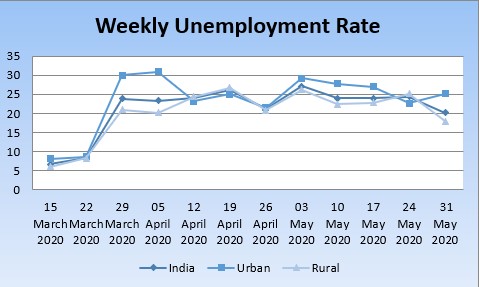Unemployment has increased sharply during the nationwide lockdown due to COVID-19 pandemic.
The Situation of Migrant Labourers
The Home Ministry made it legally compulsory for the employers to pay salaries and wages to the labours during the lockdown. Yet, the employers stopped paying them. Under such circumstances, the labours were forced to return to their hometown. By sheer pressure of circumstance, they were forced to walk on foot to their native places.
We are aware of the number of deaths due to coronavirus cases. But, we will not know how many deaths have taken place due to people falling asleep on railway tracks, job loss, hunger because there is no money to buy and children with malnutrition.
Who has been the most affected? The daily wage workers, small traders, hawkers and street vendors have been the most affected striving for their livelihood.
The Statistics
According to CMIE, the unemployment rate of India was highest on May 3rd, 2020. The report suggests that unemployment was higher in urban areas than the rural areas as urban areas are exposed to red zones. So far as May 2020 is concerned, the CMIE reports suggest that unemployment has been highest in Jharkhand and lowest in Jammu & Kashmir.
As per CMIE reports, the labour participation rate dropped from 41.9 per cent in March to 35.6 per cent in April. However, labour participation was 38.7 percent in the week ended May 24, 2020.
Weekly Unemployment during Coronavirus (in %)
| Weekly | India | Urban | Rural |
| 31 May 2020 | 20.19 | 25.14 | 17.92 |
| 24 May 2020 | 24.34 | 22.72 | 25.09 |
| 17 May 2020 | 24.01 | 26.95 | 22.79 |
| 10 May 2020 | 23.97 | 27.83 | 22.35 |
| 03 May 2020 | 27.11 | 29.22 | 26.16 |
| 26 April 2020 | 21.05 | 21.45 | 20.88 |
| 19 April 2020 | 26.19 | 25.08 | 26.69 |
| 12 April 2020 | 24.00 | 23.17 | 24.37 |
| 05 April 2020 | 23.38 | 30.93 | 20.21 |
| 29 March 2020 | 23.81 | 30.01 | 20.99 |
| 22 March 2020 | 8.41 | 8.66 | 8.29 |
| 15 March 2020 | 6.74 | 8.21 | 6.07 |
Source: CMIE, Centre for Monitoring Indian Economy

Measures taken by the Government
The government has committed to grant subsidies to 8 crore migrants by providing 5 kg of wheat/ rice per person and 1 kg channa /family per month for two months.
The 20 lakh package benefits the migrant workers, farmers and the poor in the following way:
- Interest Subvention for MUDRA Shishu loans: Rs. 1,500 crore
- Housing CLSS-MIG: Rs. 70,000 crore
- Additional emergency WCF through Nabard: Rs. 30,000 crore
- Additional credit with the help of KCC: Rs. 2 lakh crore
- special credit benefit for street vendors: Rs. 5000 crore.
According to Niti Ayog Vice-Chairman, Arvind Panagariya believes that the global labour market will extend as the workers will work from their remote countries.
US economy is much larger than the Indian Economy. Most of the observant believe that the US can afford to stay unemployed. The government provides assistance and enormous fiscal package to fight with the pandemic COVID-19. However, in India, the assistance provided by the government with 20 lakh package benefits little as compared to the full strength of the economy. Also, the government took too long for the same as compared to the United States.
How is the future?
According to CMIE, the number of farmers has increased in March and April 2020 as compared to 2019-20. But, an increase in farmers in such a situation is nothing but disguised employment. The unemployment increased when the labour migrants reverted to their native places. However, when India showed relaxation in lockdown, the labour market started improving gradually. Nevertheless, the labour market conditions are affected by post lockdown.
Labour force involve people who are of working age and willing to work at a given wage rate. According to CMIE, the weekly reports suggest that the discouraged workers seem to return to their jobs which account for good news.
Also, Niti Ayog Vice-Chairman said that poverty can be combated if some people from the farming move to low skill industry which makes much sense in the present situation.
Many have lost jobs whether be it wage-jobs or salaried jobs. This will have long term implications for savings and investments. Also, salaried jobs are difficult to revive.
Labour is among the most important factors of production which has faced devastating effects in factor payments. However, the future of labours seems worrisome and of struggling nature.
Libertatem.in is now on Telegram. Follow us for regular legal updates and judgements from the court. Follow us on Google News, Instagram, LinkedIn, Facebook & Twitter. You can also subscribe for our Weekly Email Updates. You can also contribute stories like this and help us spread awareness for a better society. Submit Your Post Now.

